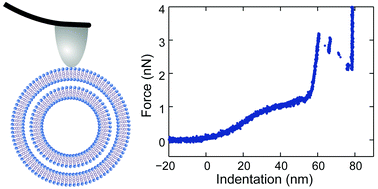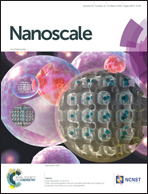Multilamellar nanovesicles show distinct mechanical properties depending on their degree of lamellarity†
Abstract
Small multilamellar vesicles may have benefits over unilamellar vesicles for drug delivery, such as an increased volume for hydrophobic drugs. In addition, their altered mechanical properties might be beneficial for cellular uptake. Here, we show how atomic force microscopy (AFM) can be used to detect and characterize multilamellar vesicles. We quantify the size of each break event occurring during AFM nanoindentations, which shows good agreement with the thickness of supported lipid bilayers. Analyzing the size and number of these events for individual vesicles allows us to distinguish between vesicles consisting of 1 up to 5 bilayers. We validate these results by comparison with correlative cryo-electron microscopy (cryo-EM) data at the vesicle population level. Finally, we quantify the vesicle geometry and mechanical properties, and show that with additional bilayers adherent vesicles are more spherical and stiffer. Surprisingly, at ∼20% stiffening for each additional bilayer, the vesicle stiffness scales only weakly with lamellarity. Our results show the potential of AFM for studying liposomal nanoparticles and suggest that small multilamellar vesicles may have beneficial mechanical properties for cellular uptake.



 Please wait while we load your content...
Please wait while we load your content...